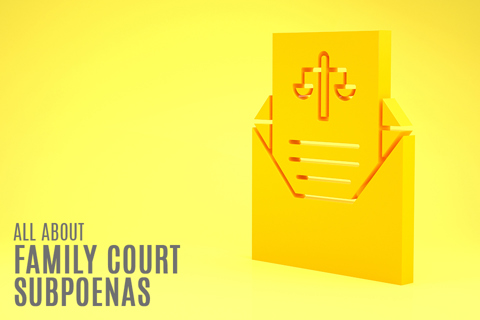Family Court subpoenas; how to issue or how to respond?

In Family Court proceedings, at times, it is difficult to get the information you need out of the other party. You may need to issue a subpoena. A subpoena is a court-ordered request to produce documents for someone to appear in a legal proceeding. In family law, you can issue a subpoena to a party to produce documents that you may need to progress your case.
Your subpoena will require someone who is not a party to a case (for example, a bank or account in financial matters or a child’s school or doctor in parenting matters), to produce documents to the Court, which are then also made to the parties in the matter.
When a subpoena is issued, it is directed to the subpoena recipient. It should set out the description of the documents that are being sought. The Court will also put into the subpoena (when filed) a deadline for compliance.
What if I am issued with a subpoena for documents relating to someone else?
Subpoenas are often directed to people to provide information about someone else. Examples of this include:
- a subpoena directed to a child’s treating medical practitioner about documents relating to the child;
- a subpoena directed to a bank seeking bank statements for a customer of the bank.
It is important to note, a subpoena is an Order of the Court; you must comply with it.
If you are issued with a subpoena to produce documents relating to someone else, strictly speaking, the person seeking the subpoena should have let them know. If you are unsure whether or not the person to whom the documents relate to, is aware of the subpoena, you should provide notice to them.
Drafting a subpoena
A template subpoena document can be downloaded from the Family Court of Australia or, for specific matters in Western Australia, from the Family Court of Western Australia.
Whilst the form itself is not difficult to complete, when you are required to set out the schedule of documents you wish to be produced, you need to ensure these are specific, including the type of document and date range.
The subpoena recipient is entitled to be paid for complying with the subpoena.
A well-drafted subpoena, narrowing the scope of documents to be produced, should reduce the costs for compliance.
If you are looking for particular information by way of subpoena, but you are unsure which document would contain what you need, it is often wise to make contact with the subpoena recipient prior and ask them which document you should seek to be provided.
If you seek documents that are too broad or vague, it is open to the subpoena recipient to object to compliance as it is too onerous to comply.
Once drafted, you need to file the subpoena with the Court. You need to ensure the Court is aware of the relevance of the subpoena to progressing your matter. Further, if you do not have leave of the Court to issue a subpoena, you need to seek leave before the subpoena can be filed. You ‘seek leave’ by writing a letter to the court, when you attempt to file your subpoena, setting out why it is relevant.
If filed, the Court will allocate a date for compliance. The intention of the Court is to allocate a date that leaves sufficient time for the subpoena to be served and for the subpoena recipient to be able to comply.
You then need to arrange time for the subpoena to be served on the recipient, including payment of the requisite conduct monies (payment for compliance).
I have been served with a subpoena
If you have been served with a subpoena, you must take all steps to comply within the production date (marked on the front page of the subpoena).
You are entitled to be paid reasonable costs for compliance with a subpoena. In the event the party who issued you with the subpoena has not provided you with enough monies to comply, you should write to the issuing party with an estimate of costs and seek such funds be secured prior to your compliance.
If you need an extension of time, then you need to write (at first instance) to the party who issued the subpoena and seek their consent for more time.
You should then begin collating the documents sought in the subpoena. Strictly speaking, the documents to be produced by way of subpoena should be your original documents. However, in most instances, parties are content with copies if they are legible.
If the documents are available in electronic form, this can be easier to produce and significantly reduce the costs of compliance.
It is important to note when the documents are collated, they are to be returned to the Family Court – not to the party who issued the subpoena. These details should be set out in the subpoena.
The Court holds subpoena documents, not the parties.
It is then a matter for the Court whether they make Orders to inspect only or to allow the documents to be inspected and copied.
Objecting to a subpoena
There are generally 3 objections raised to a subpoena. They are:
- The subpoena is not valid for technical reasons (a legal debate);
- A general objection against a valid subpoena;
- The documents sought in the subpoena contain privileged information or specific protections.
If you intend on lodging an objection to a subpoena, we would always recommend you seek legal advice as the technicalities around this process are often difficult for those not proficient in the Family Court.
Moving forward
Issuing a subpoena can be a great way to call for information without engaging in endless legal correspondence seeking the same document over and over.
It can progress your matter expeditiously as the documents are provided by the source.
The technical process of issuing and complying with subpoenas needs to be carefully reviewed before issuing the document. The rules of service must be followed and then once the compliance date has passed, the filing of the Notice of Request to Inspect.
The Notice of Request to Inspect is a document available from the Court website that the issuing party of the subpoena must complete and file prior to parties being able to inspect subpoena material produced. You need to carefully read this document prior to completion.
Contacting Meillon & Bright
Family Lawyers Perth & Sydney
The information contained in this article is of general nature and should not be construed as legal advice. If you require further information, advice or assistance for your specific circumstances, please contact Meillon & Bright Family Lawyers.

